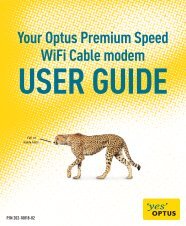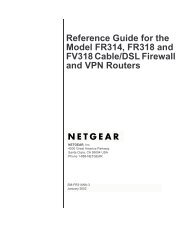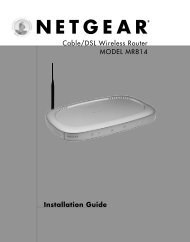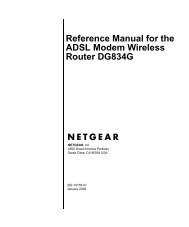Reference Manual for the Model CG814M Wireless Cable ... - netgear
Reference Manual for the Model CG814M Wireless Cable ... - netgear
Reference Manual for the Model CG814M Wireless Cable ... - netgear
You also want an ePaper? Increase the reach of your titles
YUMPU automatically turns print PDFs into web optimized ePapers that Google loves.
<strong>Reference</strong> <strong>Manual</strong> <strong>for</strong> <strong>the</strong> <strong>Model</strong> <strong>CG814M</strong> <strong>Wireless</strong> <strong>Cable</strong> Modem Gateway<br />
Note: The available channels supported by <strong>the</strong> wireless products in various countries are different.<br />
The preferred channel separation between <strong>the</strong> channels in neighboring wireless networks is 25<br />
MHz (5 channels). This means that you can apply up to three different channels within your<br />
wireless network. There are only 11 usable wireless channels in <strong>the</strong> United States. It is<br />
recommended that you start using channel 1 and grow to use channel 6, and 11 when necessary, as<br />
<strong>the</strong>se three channels do not overlap.<br />
E<strong>the</strong>rnet Cabling<br />
Although E<strong>the</strong>rnet networks originally used thick or thin coaxial cable, most installations currently<br />
use unshielded twisted pair (UTP) cabling. The UTP cable contains eight conductors, arranged in<br />
four twisted pairs, and terminated with an RJ45 type connector. A normal "straight-through" UTP<br />
E<strong>the</strong>rnet cable follows <strong>the</strong> EIA568B standard wiring as described in Table 6-1.<br />
Table 6-1. UTP E<strong>the</strong>rnet cable wiring, straight-through<br />
Pin Wire color Signal<br />
1 Orange/White Transmit (Tx) +<br />
2 Orange Transmit (Tx) -<br />
3 Green/White Receive (Rx) +<br />
4 Blue<br />
5 Blue/White<br />
6 Green Receive (Rx) -<br />
7 Brown/White<br />
8 Brown<br />
Uplink Switches and Crossover <strong>Cable</strong>s<br />
In <strong>the</strong> wiring table, <strong>the</strong> concept of transmit and receive are from <strong>the</strong> perspective of <strong>the</strong> PC. For<br />
example, <strong>the</strong> PC transmits on pins 1 and 2. At <strong>the</strong> hub, <strong>the</strong> perspective is reversed, and <strong>the</strong> hub<br />
receives on pins 1 and 2. When connecting a PC to a PC, or a hub port to ano<strong>the</strong>r hub port, <strong>the</strong><br />
transmit pair must be exchanged with <strong>the</strong> receive pair. This exchange is done by one of two<br />
mechanisms. Most hubs provide an Uplink switch which will exchange <strong>the</strong> pairs on one port,<br />
allowing that port to be connected to ano<strong>the</strong>r hub using a normal E<strong>the</strong>rnet cable. The second<br />
method is to use a crossover cable, which is a special cable in which <strong>the</strong> transmit and receive pairs<br />
Networks, Routing, and Firewall Basics B-15
















